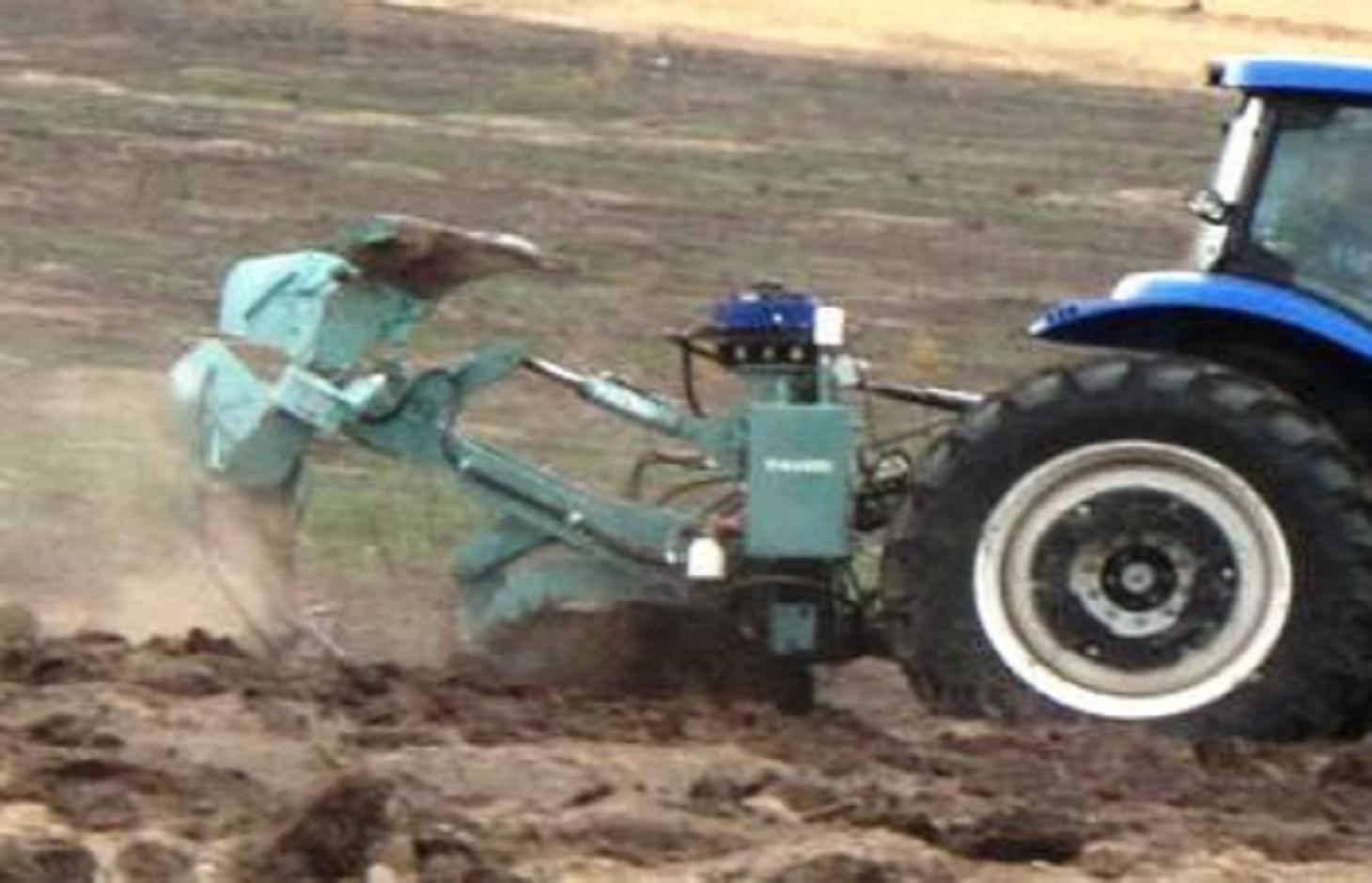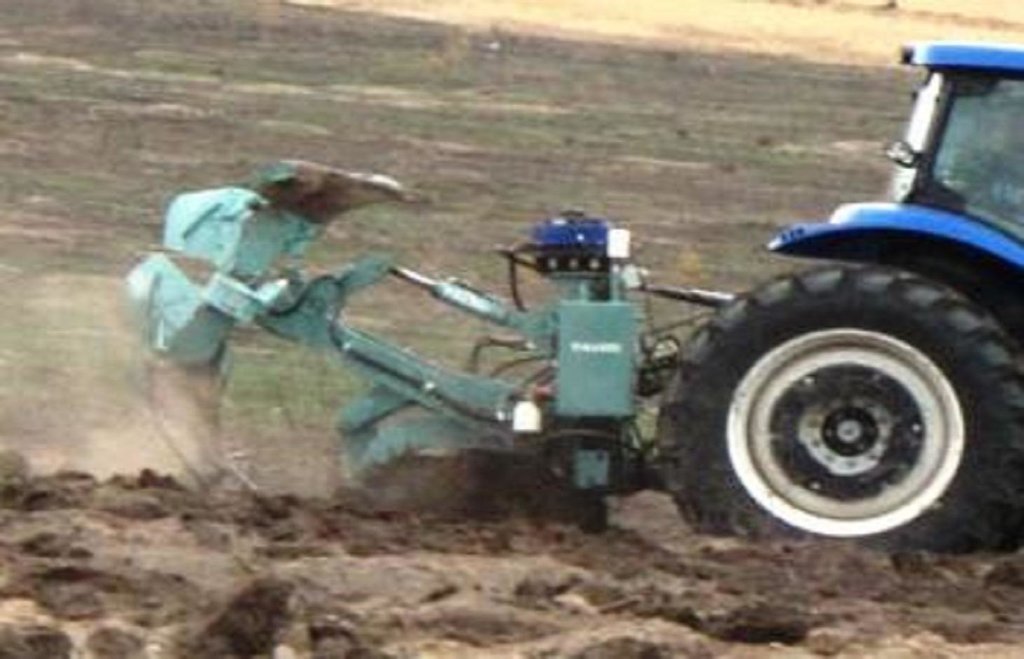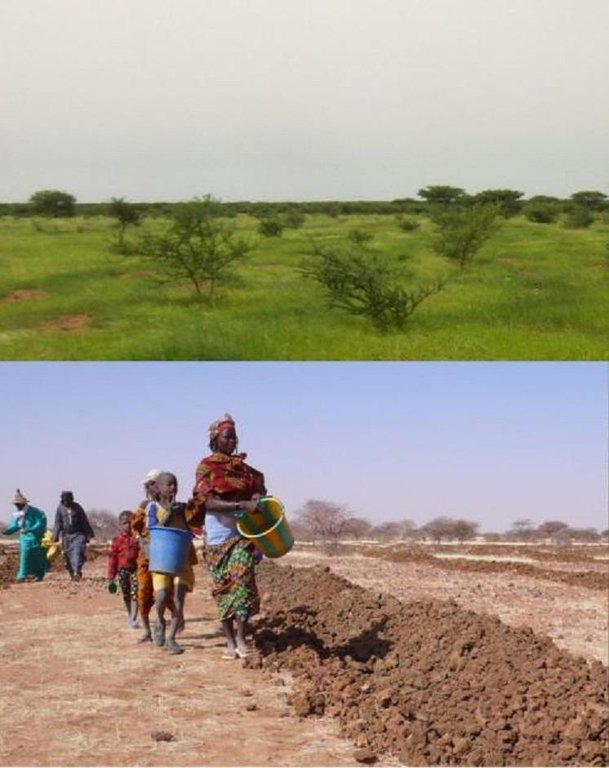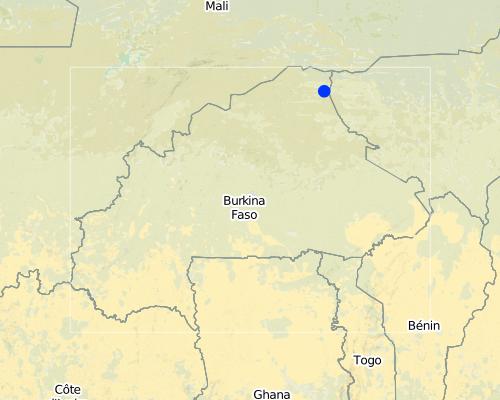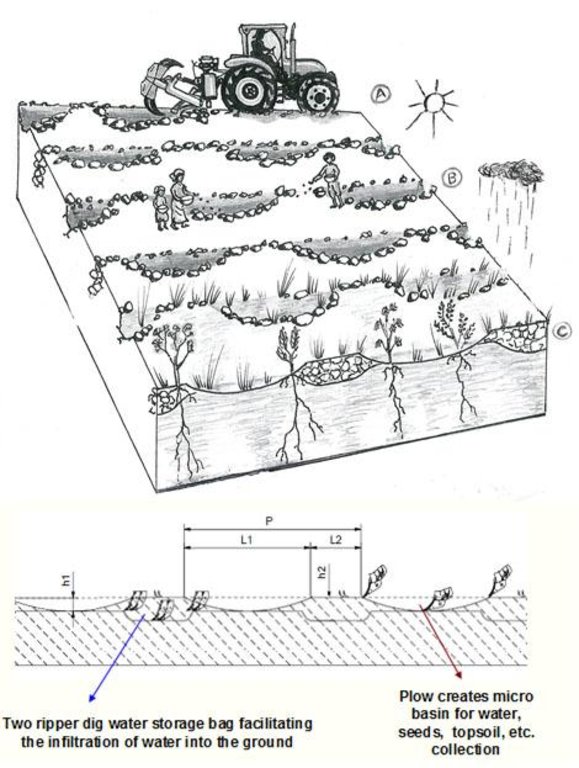Vallerani system [Burkina Faso]
- Creación:
- Actualización:
- Compilador: Sabina Galli Vallerani
- Editor: –
- Revisor: Deborah Niggli
technologies_1528 - Burkina Faso
- Resumen completo en PDF
- Resumen completo en PDF para imprimir
- Resumen completo en el navegador
- Resumen completo (sin formato)
- Vallerani System: 16 de julio de 2018 (inactive)
- Vallerani System: 16 de julio de 2018 (inactive)
- Vallerani System: 12 de julio de 2018 (inactive)
- Vallerani System: 15 de agosto de 2018 (inactive)
- Vallerani system: 4 de abril de 2018 (inactive)
- Vallerani system: 4 de enero de 2017 (inactive)
- Vallerani System: 30 de septiembre de 2020 (public)
- Vallerani System: 8 de marzo de 2019 (inactive)
Visualizar secciones
Expandir todo Colapsar todos1. Información general
1.2 Detalles de contacto de las personas de referencia e instituciones involucradas en la evaluación y la documentación de la Tecnología
1.3 Condiciones referidas al uso de datos documentados mediante WOCAT
¿Cuándo se compilaron los datos (en el campo)?
03/05/2012
El compilador y la/s persona(s) de referencia claves aceptan las condiciones acerca del uso de los datos documentados mediante WOCAT:
Sí
1.4 Declaración de la sostenibilidad de la Tecnología descrita
¿La Tecnología aquí descrita resulta problemática en relación a la degradación de la tierra, de tal forma que no puede considerársela una tecnología sostenible para el manejo de la tierra?
No
2. Descripción de la Tecnología MST
2.1 Breve descripción de la Tecnología
Definición de la Tecnología:
A special tractor-pulled plough that automatically constructs water-harvesting catchments, ideally suited for large-scale reclamation work.
2.2 Descripción detallada de la Tecnología
Descripción:
The Vallerani implement is a modified plow named Delfino3, pulled by a heavy-duty tractor. A normal plow on flat land excavates a symmetrical furrow, and earth piles up equally on both sides of the furrow. The Delfino3 plow has a single reversible plowshare that creates an angled furrow and piles up the excavated soil only on the lower (downhill) side. This soil forms a ridge that stops or slows down runoff water as it flows downhill. The plow’s blade moves up and down (i.e. in and out of the soil), creating micro basins about 5 meters long, 50 cm deep and spaced about 2 m, each with a ridge. Two ripper placed before the plow work the soil to a depth of 70 cm, rise at the basin and descend between the basins. Thus to attain, in the stretch of land between the crescent, a collection bag which receives water from the crescents itself. Even with very low rainfall (150-500 mm/year) each micro-basin/storage bag can collect 1500 litres of water, including runoff. This water is protected against evaporation and remains available to plant roots and groundwater.
The Vallerani System is based on direct sowing of seeds of shrubs and trees of locally available, indigenous species. They are sown along the ridges of the basins and in the wake of the ripper. In the case study area Acacia tortilis, Ziziphus mauritania, Balanites aegyptiaca, Acacia senegal, Acacia seyal and Faidherbia albida have been sown. While for most species seeds can be collected by the local population, for species rarely present in the region, the seeds have to be purchased from tree nurseries. The use of goat excrements containing seeds has also proven successful (about 95% of all micro basin have at least one tree growing after 3 years) when directly sown. With more moisture available for a long time trees grow rapidly and the herbaceous cover improves in quality and in quantity - providing 20-30 times more livestock fodder (1000-2000kg dry herbaceous biomass ha/year), also helping to conserve the soil. The plowed and sown area is not protected by fences, grazing of animals shall be allowed so that villagers can benefit from the forage and reduce the accumulation of biomass fuel that would further the risk of fires in the dry season.
The Vallerani plow can ‘treat’ up to 20 ha, digging 5.720 micro basins, in a single day. The speed and effectiveness of the Delfino3 plow are its major advantages in the fight against desertification, but can also be its major limitation as to be able to make the best of it, it is necessary to find great availability of land to be reforested or cultivate. This is mainly possible related to a large public or business initiative. The spreading "like wildfire" that has characterized the case study was made possible by the presence on the territory of an NGO already active and rooted in the territory for many years and by perseverance, respect and competence of partner "of the North". Once the project has invested in the tractor and the plow (tractor ~ 70,000 EUR, plough ~ 40,000 EUR), the remaining cost of implementation – labour costs for local workers and drivers, fuel etc. amount to around EUR 125 / ha / year.
The case study area in the north east of Burkina Faso receives about 300-500 mm of annual rainfall. The soils of this agropastoral land are heavily degraded with a low tree density and an almost entirely absent herbaceous cover.
2.3 Fotografías de la Tecnología
2.5 País/ región/ lugares donde la Tecnología fue aplicada y que se hallan comprendidos por esta evaluación
País:
Burkina Faso
Región/ Estado/ Provincia:
Oudalan
Especifique más el lugar :
Gorom-Gorom
Map
×2.6 Fecha de la implementación
Si no se conoce el año preciso, indique la fecha aproximada:
- 10-50 años atrás
2.7 Introducción de la Tecnología
Especifique cómo se introdujo la Tecnología:
- durante experimentos/ investigación
3. Clasificación de la Tecnología MST
3.1 Propósito(s) principal(es) de la Tecnología MST
- mejorar la producción
- reducir, prevenir, restaurar la degradación de la tierra
3.2 Tipo(s) actuales de uso de la tierra donde se aplica la Tecnología

Tierra de pastoreo
Tierras de pastoreo extensivo:
- Semi-nomadismo/ pastoralismo

Cultivos asociados (cultivos/ pastoreo/ árboles), incl. agroforestería
Comentarios:
Major land use problems (compiler’s opinion): Land degradation-desertification with reduction of vegetation cover in terms of plant density and species diversity is the main problem: disappearance of grasses and trees, reduction of the size of the plants that are resistant and of the biological activity of the soil. Runoff, water and wind erosion increase. Drought and irregular precipitation have heavy consequences on soil fertility, availability of water for humans and livestock, and recharging groundwater.
3.3 Información adicional sobre el uso de tierras
Provisión de agua para la tierra donde se aplica la Tecnología:
- de secano
Número de temporadas de cultivo por año:
- 1
Especifique:
Longest growing period in days: 90
3.4 Grupo MST al que pertenece la Tecnología
- cosecha de agua
3.5 Difusión de la Tecnología
Comentarios:
Total area covered by the SLM Technology is 50 m2.
3.6 Medidas MST que componen la Tecnología

medidas vegetativas
- V1: Cubierta de árboles y arbustos
- V2: Pastos y plantas herbáceas perennes

medidas estructurales
- S4: Acequias niveladas, fosas

medidas de manejo
- M2: Cambio de gestión/ nivel de intensidad
3.7 Principales tipos de degradación de la tierra encarados con la Tecnología

erosión de suelos por agua
- Wt: pérdida de capa arable/ erosión de la superficie
- Wg: erosión en cárcavas

erosión de suelos por viento
- Et: pérdida de capa arable

deterioro químico del suelo
- Cn: reducción de la fertilidad y contenido reducido de la materia orgánica del suelo (no ocasionados por la erosión)

deterioro físico del suelo
- Pc: compactación

degradación biológica
- Bc: reducción de la cobertura vegetal del suelo
- Bh: pérdida de hábitats
- Bs: reducción en la calidad y composición/ diversidad de las especies
Comentarios:
Main causes of degradation: over-exploitation of vegetation for domestic use, overgrazing, change of seasonal rainfall, droughts
Secondary causes of degradation: deforestation / removal of natural vegetation (incl. forest fires), education, access to knowledge and support services
3.8 Prevención, reducción o restauración de la degradación de la tierra
Especifique la meta de la Tecnología con relación a la degradación de la tierra:
- restaurar/ rehabilitar tierra severamente degradada
4. Especificaciones técnicas, actividades de implementación, insumos y costos
4.1 Dibujo técnico de la Tecnología
4.2 Especificaciones técnicas/ explicaciones del dibujo técnico
Above:
A. The land chosen together with the local population is plowed with the special Delfino3 plow. B. Local people sow seeds (collected from local trees or bought if species are rare) or goat dung containing seeds (collected in the night enclosures after feeding the goats shaking trees with ripe seeds). C. The micro basins collect the rain that falls into the crescents and 50% of the runoff water. The water easily penetrates into the soil, fills the storage bags, remains available to plant roots and drains into the groundwater without risk of evaporation. Each micro basin/storage bag can collect up to 1.500 l of water.
Below
h1-Depth of the ploughshares work: =40/50 cm
Width of the micro basin: 40/50 cm
L1-Length of the micro basin, programmable: =3,5/5 m
h2 Depth of the rippers work: =50/80 cm
P-Total length of work: 4/8 m
Tractors horsepower 210/250 (150-198 Kw)
Working speed: 4/7 Km/h
Weight : 2000 Kg
Location: Oudalan, Gorom Gorom province. Burkina Faso
Technical knowledge required for field staff / advisors: high
Main technical functions: control of raindrop splash, improvement of ground cover, improvement of topsoil structure (compaction), stabilisation of soil (eg by tree roots against land slides), water harvesting / increase water supply, increase of biomass (quantity), promotion of vegetation species and varieties (quality, eg palatable fodder)
Secondary technical functions: increase in organic matter, increase in nutrient availability (supply, recycling,…), increase of infiltration, increase / maintain water stored in soil
Retention/infiltration ditch/pit, sediment/sand trap
Spacing between structures (m): 0.5
Depth of ditches/pits/dams (m): 2
Length of ditches/pits/dams (m): 5
Change of land use practices / intensity level
4.4 Actividades de establecimiento
| Actividad | Tipo de medida | Momento | |
|---|---|---|---|
| 1. | Project planning, consulting and training by VS and national experts | Estructurales | |
| 2. | Plowing with the Delfino special plow pulled by a 210hp tractor | Estructurales | Dry season |
| 3. | Seed harvesting can be done by local people either collecting them directly from plants or by shaking the plants at the appropriate time, to feed the goats and sheep with the fallen seeds and collect their dung in the night enclosure | Estructurales | |
| 4. | Missing seeds can be purchased in local markets or, if trees are too rare or if the species is no longer present, seeds must be purchased at a nursery | Estructurales | When seeds are ripe |
| 5. | Direct sowing | Estructurales | Dry season |
4.5 Costos e insumos necesarios para el establecimiento
| Especifique insumo | Unidad | Cantidad | Costos por unidad | Costos totales por insumo | % de los costos cubiertos por los usuarios de las tierras | |
|---|---|---|---|---|---|---|
| Mano de obra | labour | ha | 1,0 | 72,0 | 72,0 | 50,0 |
| Equipo | machine use | ha | 1,0 | 23,4 | 23,4 | |
| Costos totales para establecer la Tecnología | 95,4 | |||||
4.6 Actividades de establecimiento/ recurrentes
| Actividad | Tipo de medida | Momento/ frequencia | |
|---|---|---|---|
| 1. | No maintenance activities are required | Estructurales |
4.7 Costos e insumos necesarios para actividades de mantenimiento/ recurrentes (por año)
Comentarios:
All data presented in the table refer to an ideal project which lasts 5 years with 3000 hectares plowed each year. All works are carried for economic retribution. Item number 1 refers to the planning, training and consulting engineers that has a strong impact on the cost per ha ($47). This voice would remain the same if 3 MTU (Mechanized Technical Unit) were used in the same area reducing its impact to $ 15,6 per ha.
4.8 Factores más determinantes que afectan los costos:
Describa los factores más determinantes que afectan los costos:
Upfront costs for the aquisition of the required materials are around 40,000 EUR for the plough and 70,000 EUR for the tractor.
5. Entorno natural y humano
5.1 Clima
Lluvia anual
- < 250 mm
- 251-500 mm
- 501-750 mm
- 751-1,000 mm
- 1,001-1,500 mm
- 1,501-2,000 mm
- 2,001-3,000 mm
- 3,001-4,000 mm
- > 4,000 mm
Especificaciones/ comentarios sobre la cantidad de lluvia:
400-600 mm
Zona agroclimática
- árida
Thermal climate class: subtropics
5.2 Topografía
Pendientes en promedio:
- plana (0-2 %)
- ligera (3-5%)
- moderada (6-10%)
- ondulada (11-15%)
- accidentada (16-30%)
- empinada (31-60%)
- muy empinada (>60%)
Formaciones telúricas:
- meseta/ planicies
- cordilleras
- laderas montañosas
- laderas de cerro
- pies de monte
- fondo del valle
Zona altitudinal:
- 0-100 m s.n.m.
- 101-500 m s.n.m.
- 501-1,000 m s.n.m
- 1,001-1,500 m s.n.m
- 1,501-2,000 m s.n.m
- 2,001-2,500 m s.n.m
- 2,501-3,000 m s.n.m
- 3,001-4,000 m s.n.m
- > 4,000 m s.n.m
5.3 Suelos
Profundidad promedio del suelo:
- muy superficial (0-20 cm)
- superficial (21-50 cm)
- moderadamente profunda (51-80 cm)
- profunda (81-120 cm)
- muy profunda (>120 cm)
Textura del suelo (capa arable):
- áspera/ ligera (arenosa)
Materia orgánica de capa arable:
- baja (<1%)
5.4 Disponibilidad y calidad de agua
Agua subterránea:
> 50 m
Disponibilidad de aguas superficiales:
bueno
Calidad de agua (sin tratar):
solo para uso agrícola (irrigación)
5.5 Biodiversidad
Diversidad de especies:
- baja
5.6 Las características de los usuarios de la tierra que aplican la Tecnología
Ingresos no agrarios:
- menos del 10% de todos los ingresos
Individuos o grupos:
- grupos/ comunal
Género:
- mujeres
- hombres
Indique otras características relevantes de los usuarios de las tierras:
Land users applying the Technology are mainly common / average land users
Difference in the involvement of women and men: The project involves the reforestation and reconstruction of the herbaceous layer for the grazing of livestock that are male dominated activities. Since 2010 women have sown special plants for medical use, domestic use and as raw material for crafts and protected them from grazing.
Population density: 10-50 persons/km2
Annual population growth: 3% - 4%
Off-farm income specification: The only activity people of the region are engaged in is goat and cattle breading. Crop production is practiced only for subsistence use.
5.7 Área promedio de la tierra que pertenece a o es arrendada por usuarios de tierra que aplican la Tecnología
- < 0.5 ha
- 0.5-1 ha
- 1-2 ha
- 2-5 ha
- 5-15 ha
- 15-50 ha
- 50-100 ha
- 100-500 ha
- 500-1,000 ha
- 1,000-10,000 ha
- > 10,000 ha
¿Esto se considera de pequeña, mediana o gran escala (refiriéndose al contexto local)?
- pequeña escala
5.8 Tenencia de tierra, uso de tierra y derechos de uso de agua
Tenencia de tierra:
- estado
- comunitaria/ aldea
Derechos de uso de tierra:
- acceso abierto (no organizado)
- comunitarios (organizado)
Derechos de uso de agua:
- acceso abierto (no organizado)
- comunitarios (organizado)
5.9 Acceso a servicios e infraestructura
salud:
- pobre
- moderado
- bueno
educación:
- pobre
- moderado
- bueno
asistencia técnica:
- pobre
- moderado
- bueno
empleo (ej. fuera de la granja):
- pobre
- moderado
- bueno
mercados:
- pobre
- moderado
- bueno
energía:
- pobre
- moderado
- bueno
caminos y transporte:
- pobre
- moderado
- bueno
agua potable y saneamiento:
- pobre
- moderado
- bueno
servicios financieros:
- pobre
- moderado
- bueno
6. Impactos y comentarios para concluir
6.1 Impactos in situ demostrados por la Tecnología
Impactos socioeconómicos
Producción
producción de forraje
Comentarios/ especifique:
up to 30% more than before implementation
calidad de forraje
producción de madera
Cantidad antes de MST:
50 trees/ha
Cantidad luego de MST:
350 trees/ha
Impactos socioculturales
seguridad alimentaria/ autosuficiencia
Comentarios/ especifique:
The technology can be applied for agriculture producing 2 to 4 times more than with traditional systems
situación de salud
Comentarios/ especifique:
No more malnutrition=better health!
oportunidades culturales
oportunidades recreativas
Comentarios/ especifique:
More wood, fodder and water available= more time available
instituciones comunitarias
Comentarios/ especifique:
Old, young and woman work together for common benefits
instituciones nacionales
Comentarios/ especifique:
Were applied on large scale
MST/ conocimiento de la degradación de la tierra
Comentarios/ especifique:
Environment education in theory and practice, is part of the system
mitigación de conflicto
Comentarios/ especifique:
More fodder and water highly reduces conflict motivations
situación de grupos en desventaja social y económica
Comentarios/ especifique:
Women have collected, sown and protected medicinal plants and plants for raw materials for handcrafts to sell at the market
Training of skilled labour in disadvantaged regions
Comentarios/ especifique:
Chance to find good jobs
contribution to human well-being
Comentarios/ especifique:
Thanks to the enormous increase of trees, pasture and crop production, the quality of life and health of men and animals have improved considerably.
Impactos ecológicos
Ciclo de agua/ escurrimiento de sedimento
cosecha/ recolección de agua
escurrimiento superficial
nivel freático/ acuífero
Suelo
humedad del suelo
pérdida de suelo
compactación de suelo
ciclo/ recarga de nutrientes
materia orgánica debajo del suelo C
Biodiversidad: vegetación, animales
biomasa/ sobre suelo C
Reducción de riesgos de desastres y riesgos climáticos
riesgo de incendio
Comentarios/ especifique:
Through the high soil cover with trees and grass fire risk increase, this is avoided through open access to grazing.
Otros impactos ecológicos
Increased threat from wild animals
Comentarios/ especifique:
Biodiversity highly increases, local people might be afraid of some animals coming back like jackal or snakes
6.2 Impactos fuera del sitio demostrados por la Tecnología
inundaciones río abajo
daños a infraestructura pública / privada
6.3 Exposición y sensibilidad de la Tecnología al cambio climático gradual y a extremos relacionados al clima/ desastres (desde la percepción de los usuarios de tierras)
Cambio climático gradual
Cambio climático gradual
| Estación | tipo de cambios climáticos/ climas extremos | ¿Cómo es que la tecnología soporta esto? | |
|---|---|---|---|
| temperatura anual | incrementó | bien |
Extremos (desastres) relacionados al clima
Desastres climatológicos:
| ¿Cómo es que la tecnología soporta esto? | |
|---|---|
| tormenta de lluvia local | bien |
| tormenta de viento | bien |
Desastres climatológicos
| ¿Cómo es que la tecnología soporta esto? | |
|---|---|
| sequía | bien |
Desastres hidrológicos
| ¿Cómo es que la tecnología soporta esto? | |
|---|---|
| inundación general (río) | no se sabe |
Otras consecuencias relacionadas al clima
Otras consecuencias relacionadas al clima
| ¿Cómo es que la tecnología soporta esto? | |
|---|---|
| periodo reducido de crecimiento | bien |
6.4 Análisis costo-beneficio
¿Cómo se comparan los beneficios con los costos de establecimiento (desde la perspectiva de los usuarios de tierra)?
Ingresos a corto plazo:
muy negativo
Ingresos a largo plazo:
muy positivo
¿Cómo se comparan los beneficios con los costos de mantenimiento/ recurrentes (desde la perspectiva de los usuarios de tierra)?
Ingresos a corto plazo:
negativo
Ingresos a largo plazo:
muy positivo
6.5 Adopción de la Tecnología
- más de 50%
De todos quienes adoptaron la Tecnología, ¿cuántos lo hicieron espontáneamente, es decir, sin recibir incentivos/ pagos materiales?
- 0-10%
Comentarios:
100% of land user families have adopted the Technology with external material support
Comments on acceptance with external material support: The system includes the use of a heavy duty tractor and a special plow whose costs are high though difficult to sustain by the local population. All correlated activities are done (or can be done) without external material support
There is a strong trend towards spontaneous adoption of the Technology
The system includes the use of a heavy duty tractor and a special plow whose cost is high though difficult to sustain by the local population. All other activities part of the system are practicable from the population under an initial guidance of someone with specific training. Where the technology is known there is active participation of local people and a strong demand for new interventions
6.7 Fuerzas/ ventajas/ oportunidades de la Tecnología
| Fuerzas/ ventajas/ oportunidades desde la perspectiva del compilador o de otra persona de referencia clave |
|---|
| This practice allows for the rapid and efficient treatment of large degraded areas within a short time |
| The tree and shrub species planted are mainly indigenous and locally adapted species |
| Through its tillage process the Vallerani system offers the highest degree of efficiency in the first years from processing. Its effects last for a long time so it does not need to be repeated on the same site |
| The VS does not use any water (except rain) in countries where water is rare and precious. It further avoids the risk of soil salinisation. |
| The delfino3 can plow strongly degraded land, this makes that local people often ask to work their worse land |
6.8 Debilidades/ desventajas/ riesgos de la Tecnología y formas de sobreponerse a ellos
| Debilidades/ desventajas/ riesgos desde la perspectiva del compilador o de otra persona de referencia clave | ¿Cómo sobreponerse a ellas? |
|---|---|
| The investment costs for the machinery are extremely high and cannot be covered by single land users or even communities | projects must be financed externally |
| The speed and effectiveness of the Delfino3 plow are its major advantages in the fight against desertification, but can also be its major limitation as to be able to make the best of it, it is necessary to find great availability of land to be reforested or cultivate | This is mainly possible related to a large public or business initiative. The spreading "like wildfire" that has characterized the case study was made possible by the presence on the territory of an NGO already active and rooted in the territory for many years and by perseverance, respect and competence of the partner "of the North" |
| Since great extentions will be processed, a big organisation is needed for all activities (awareness raising, collecting seeds, personnel training, logistics, etc), | this must be well organized and should operate already before starting plowing |
7. Referencias y vínculos
7.1 Métodos/ fuentes de información
- visitas de campo, encuestas de campo
- entrevistas con usuarios de tierras
7.2 Vínculos a las publicaciones disponibles
Título, autor, año, ISBN:
Conedera, M., N. Bomio-Pacciorini, et al. 2010. Reconstitution des écosystèmes dégradés sahéliens. Bois et Forêts des Tropiques 304(2).
¿Dónde se halla disponible? ¿Costo?
http://www.vallerani.com/images/Reconstitution.pdf
Título, autor, año, ISBN:
Akhtar Ali, Theib Oweis, Atef Abdul Aal, Mohamed Mudabbar, Khaled Zubaidi, and Adriana Bruggeman. 2006. The Vallerani Water Harvesting System. ICARDA Caravan No. 23.
¿Dónde se halla disponible? ¿Costo?
http://www.vallerani.com/images/Caravan-23.pdf
Vínculos y módulos
Expandir todo Colapsar todosVínculos
No hay vínculos
Módulos
No se hallaron módulos


